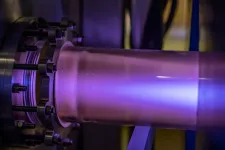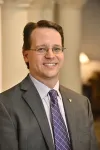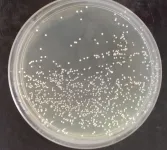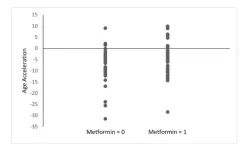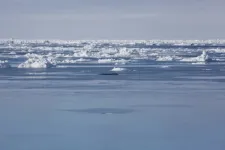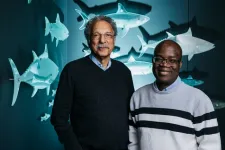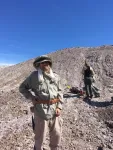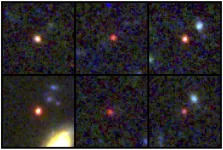(Press-News.org) West Virginia University physicists have made a breakthrough on an age-old limitation of the first law of thermodynamics.
Paul Cassak, professor and associate director of the Center for KINETIC Plasma Physics, and graduate research assistant Hasan Barbhuiya, both in the Department of Physics and Astronomy, are studying how energy gets converted in superheated plasmas in space. Their findings, funded by a grant from the National Science Foundation and published in the Physical Review Letters journal, will revamp scientists’ understanding of how plasmas in space and laboratories get heated up, and may have a wide variety of further applications across physics and other sciences.
The first law of thermodynamics states that energy can neither be created nor destroyed, but it can be converted into different forms.
“Suppose you heat up a balloon,” Cassak said. “The first law of thermodynamics tells you how much the balloon expands and how much hotter the gas inside the balloon gets. The key is that the total amount of energy causing the balloon to expand and the gas to get hotter is the same as the amount of heat you put into the balloon. The first law has been used to describe many things — including how refrigerators and car engines work. It’s one of the pillars of physics.”
Developed in the 1850s, the first law of thermodynamics is only valid for systems in which a temperature can be properly defined, a state known as equilibrium. As an example, when combined, a cup of cold water and a cup of hot water will eventually reach a warm temperature between them. This warm temperature is the equilibrium. However, when the hot and cold water have not yet reached that endpoint, the water is out of equilibrium.
Likewise, in many areas of modern science, systems are not in equilibrium. For over 100 years, researchers have attempted to expand the first law for common materials not in equilibrium, but such theories only work when the system is nearly there — when the hot and cold water are almost mixed. The theories do not work, for example, in space plasmas, which are far from equilibrium.
The work of Cassak and Barbhuiya fills in the blanks on this limitation.
“We generalized the first law of thermodynamics for systems that are not in equilibrium,” Cassak said. “We did a pencil and paper calculation to find how much energy is associated with matter not being in equilibrium, and it works whether the system is close to or far from equilibrium.”
Their research has numerous potential applications. The theory will help scientists understand plasmas in space, which is important for preparing for space weather. Space weather occurs when huge eruptions in the solar atmosphere blast superheated plasma into space. It can cause problems like power outages, interruptions to satellite communications and the rerouting of airplanes.
“The result represents a really large step of our understanding,” Cassak said. “Until now, the state-of-the-art in our research area was to account for energy conversion only associated with expansion and heating, but our theory provides a way to calculate all the energy from not being in equilibrium.”
“Because the first law of thermodynamics is so widely used,” Barbhuiya said, “it is our hope that scientists in a wide array of fields could use our result.”
For example, it may be useful for studying low-temperature plasmas — which are important for etching in the semiconductor and circuit industry — as well as in other areas like chemistry and quantum computing. It might also help astronomers study how galaxies evolve in time.
Groundbreaking research related to Cassak and Barbhuiya’s is being carried out in PHASMA, the PHAse Space MApping experiment, in the WVU Center for KINetic Experimental, Theoretical and Integrated Computational Plasma Physics.
“PHASMA is making space-relevant measurements of energy conversion in plasmas that are not in equilibrium. These measurements are totally unique worldwide,” Cassak said.
Likewise, the breakthrough he and Barbhuiya have made will change the landscape of plasma and space physics, a feat that doesn’t happen often.
“There aren’t many laws of physics — Newton's laws, the laws of electricity and magnetism, the three laws of thermodynamics, and the laws of quantum mechanics,” said Duncan Lorimer, professor and interim chair of the Department of Physics and Astronomy. “To take one of these laws that has been around over 150 years and improve on it is a major achievement.”
“This new first principles result in non-equilibrium statistical mechanics as applied to plasmas is a great example of the academic research enabled by NSF’s mission ‘to promote the progress of science’,” said Vyacheslav Lukin, a program director for plasma physics in the NSF Division of Physics.
Joining WVU researchers on the project were Haoming Liang, University of Alabama in Huntsville, and Matthew Argall, University of New Hampshire.
END
WVU physicists give the first law of thermodynamics a makeover
2023-02-22
ELSE PRESS RELEASES FROM THIS DATE:
Yeast used in production of cachaça can prevent asthma, study shows
2023-02-22
A daily dose of a strain of brewer’s yeast used to produce cachaça (distilled spirit made from fermented sugarcane juice) can act as a preventive against asthma, according to a Brazilian study involving male mice. The results are reported in an article published in the journal Probiotics and Antimicrobial Proteins. The authors are researchers at the University of São Paulo (USP) and the Federal University of Minas Gerais (UFMG). The yeast strain used in the study was Saccharomyces cerevisiae UFMG A-905.
Asthma is a common lung condition that causes breathing difficulties. It ...
Out of the blue
2023-02-22
(Santa Barbara, Calif.) — Blue foods — those that come from the ocean or freshwater environments — have tremendous potential to help address several global challenges. With careful implementation of policies that leverage these foods, nations could get a boost on efforts to reduce nutritional deficits, lower disease risk, decrease greenhouse gas emissions and ensure resilience in the face of climate change.
So say the team of experts at Blue Food Assessment, an international collaboration of scientists whose focus has been on the role of aquatic foods in global ...
Hands-free tech adds realistic sense of touch in extended reality
2023-02-22
HOUSTON – (Feb. 22, 2023) – With an eye toward a not-so-distant future where some people spend most or all of their working hours in extended reality, researchers from Rice University, Baylor College of Medicine and Meta Reality Labs have found a hands-free way to deliver believable tactile experiences in virtual environments.
Users in virtual reality (VR) have typically needed hand-held or hand-worn devices like haptic controllers or gloves to experience tactile sensations of touch. The new “multisensory pseudo-haptic” technology, which is described in an open-access ...
Physically demanding work tied to higher male fertility, study suggests
2023-02-22
A new study from researchers from Brigham and Women’s Hospital, a founding member of the Mass General Brigham healthcare system, suggests that men who regularly lift heavy objects at work have higher sperm counts. The study, published in Human Reproduction, is part of the Environment and Reproductive Health (EARTH) cohort, a clinical study which aims to explore how exposure to environmental chemicals and lifestyle choices affect reproductive health.
“We already know that exercise is associated with multiple health benefits in humans, including those observed on reproductive health, but few studies have looked at how occupational factors can ...
Aging | Metformin's impact on aging and longevity through DNA methylation
2023-02-22
“In this study, we compared genome-wide DNA methylation rates among metformin users and nonusers [...]”
BUFFALO, NY- February 22, 2023 – A new research paper was published in Aging (listed as "Aging (Albany NY)" by MEDLINE/PubMed and "Aging-US" by Web of Science) Volume 15, Issue 3, entitled, “Metformin use history and genome-wide DNA methylation profile: potential molecular mechanism for aging and longevity.”
Metformin, a commonly prescribed anti-diabetic medication, has repeatedly been shown to hinder aging in pre-clinical ...
As sea ice declines in the Arctic, bowhead whales are adjusting their migration patterns
2023-02-22
NEWPORT, Ore. – As sea ice declines in the Arctic, bowhead whales are staying north of the Bering Strait more frequently, a shift that could affect the long-term health of the bowhead population and impact the Indigenous communities that rely on the whales, a new study by Oregon State University researchers shows.
Bowhead whales found in the Pacific Arctic, sometimes called Bering-Chukchi-Beaufort bowheads based on their migratory patterns, normally winter in the northern Bering Sea and migrate north in the spring through the Bering Strait to the Canadian Beaufort Sea, where they spend summer and fall. They then migrate ...
UBC's Daniel Pauly and Rashid Sumaila win Tyler Prize for Environmental Achievement
2023-02-22
Two courageous UBC ocean fisheries experts - marine biologist Dr. Daniel Pauly and fisheries economist Dr. Rashid Sumaila — have been awarded the 2023 Tyler Prize for Environmental Achievement.
The award, administered by the University of Southern California, has often been described as the ‘Nobel Prize for the Environment.’
Both are University Killam Professors at the University of British Columbia, and long-time colleagues at its Institute for the Oceans and Fisheries. They said that winning this ...
MD Anderson Research Highlights for February 22, 2023
2023-02-22
HOUSTON ― The University of Texas MD Anderson Cancer Center’s Research Highlights showcases the latest breakthroughs in cancer care, research and prevention. These advances are made possible through seamless collaboration between MD Anderson’s world-leading clinicians and scientists, bringing discoveries from the lab to the clinic and back.
Recent developments include a new understanding of how HPV drives cancer development, a combination therapy to overcome treatment resistance in mantle cell lymphoma, novel ...
Early Cretaceous shift in the global carbon cycle affected both land and sea
2023-02-22
Scientists continue to refine techniques for understanding present-day changes in Earth’s environmental systems, but the planet’s distant past also offers crucial information to deepen that understanding. A geological study by University of Nebraska–Lincoln scientist Matt Joeckel and colleagues provides such information.
Scientific research in recent decades has confirmed that major changes in the global carbon cycle caused significant changes in the Earth’s atmosphere and oceans 135 million years ago, during the early Cretaceous Period. A range of questions remain about the ...
Discovery of massive early galaxies defies prior understanding of the universe
2023-02-22
UNIVERSITY PARK, Pa. — Six massive galaxies discovered in the early universe are upending what scientists previously understood about the origins of galaxies in the universe.
“These objects are way more massive than anyone expected,” said Joel Leja, assistant professor of astronomy and astrophysics at Penn State, who modeled light from these galaxies. “We expected only to find tiny, young, baby galaxies at this point in time, but we’ve discovered galaxies as mature as our own in what was previously understood to be the dawn of the universe.”
Using the first dataset released from NASA's James Webb Space Telescope, ...
